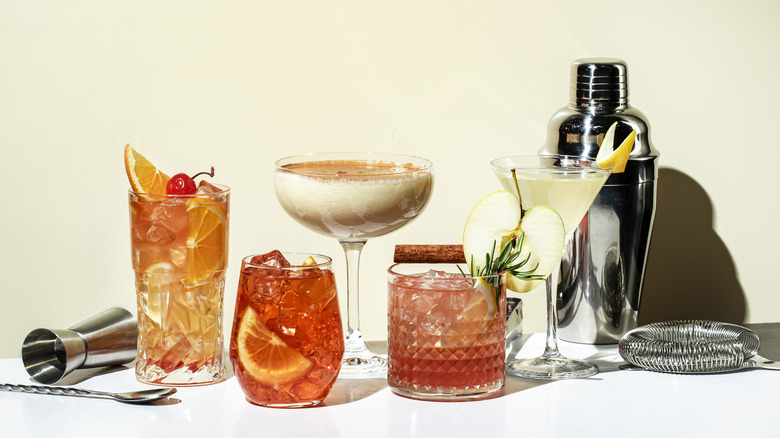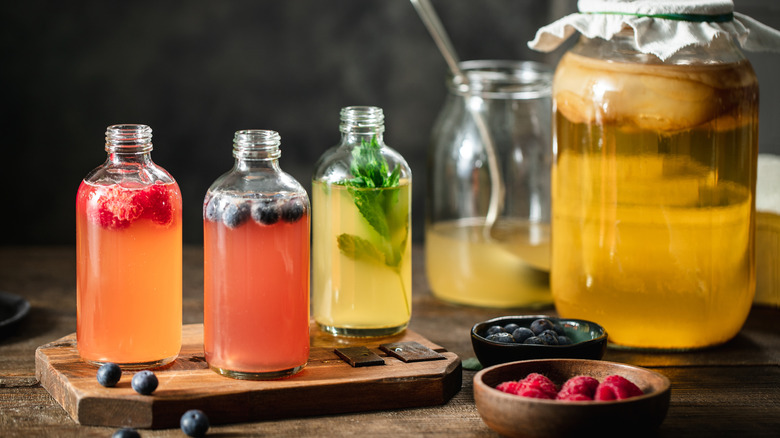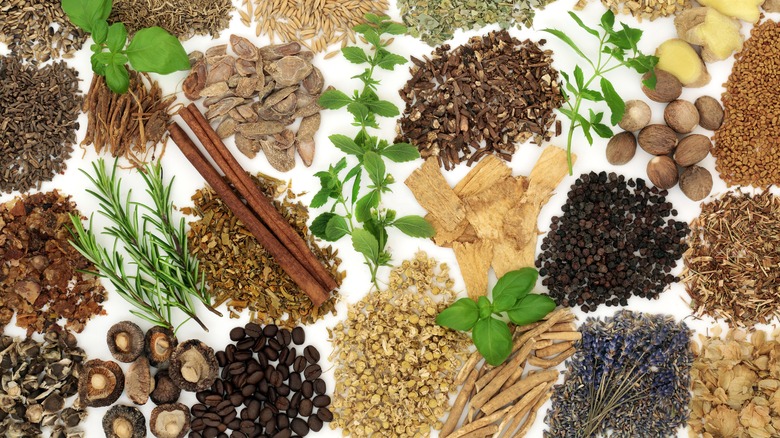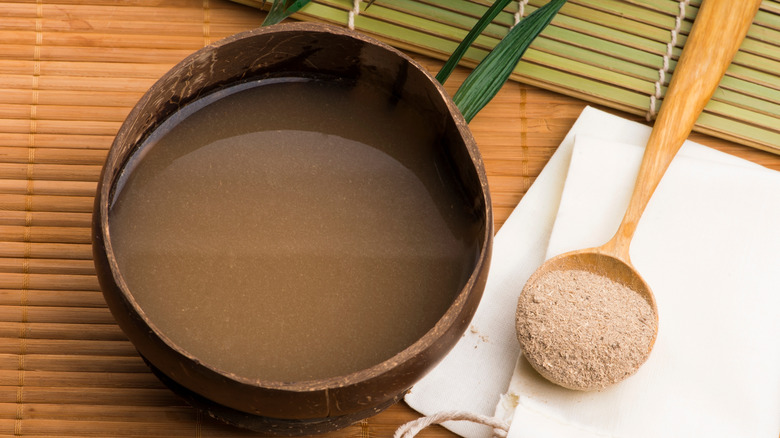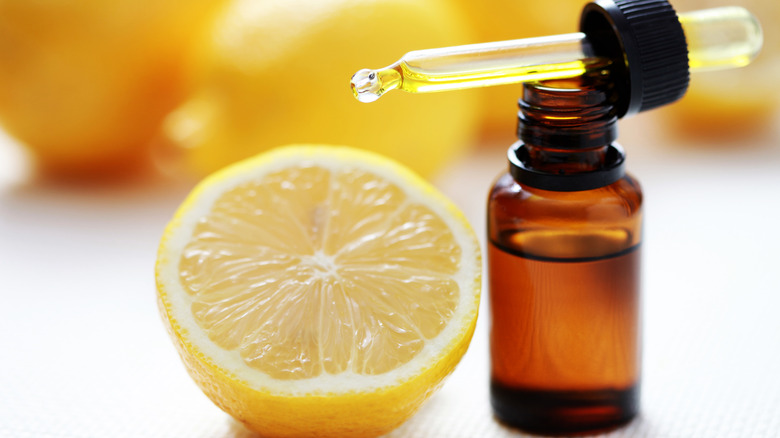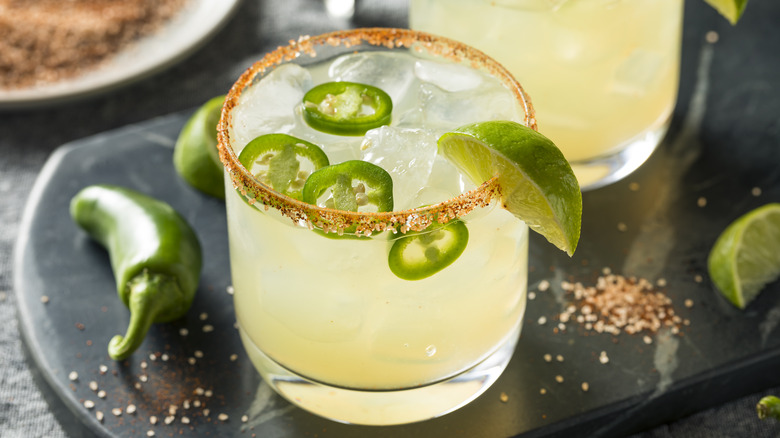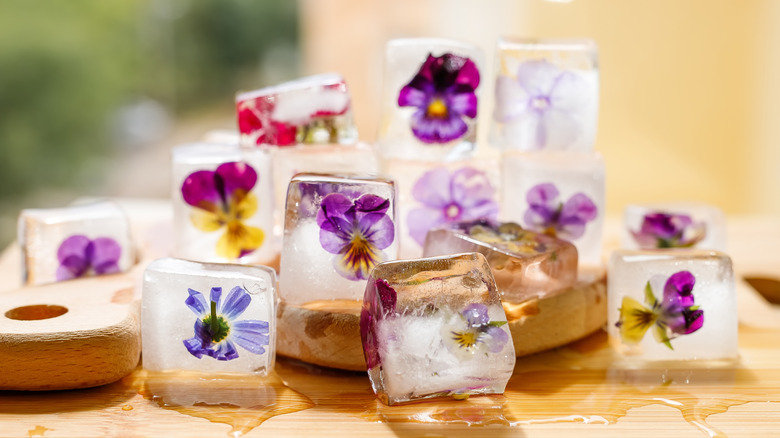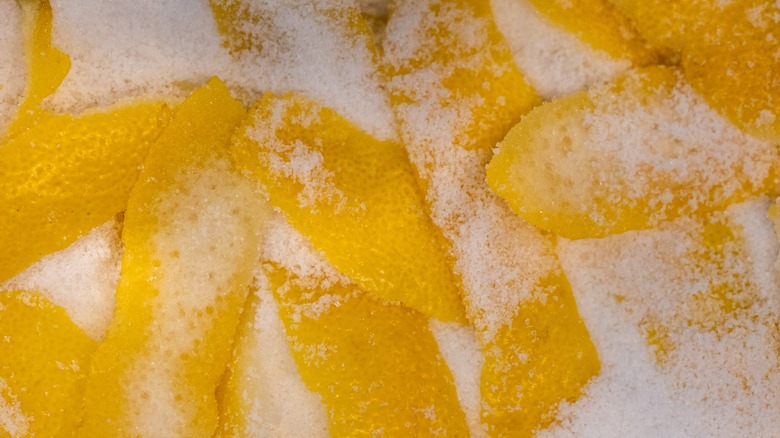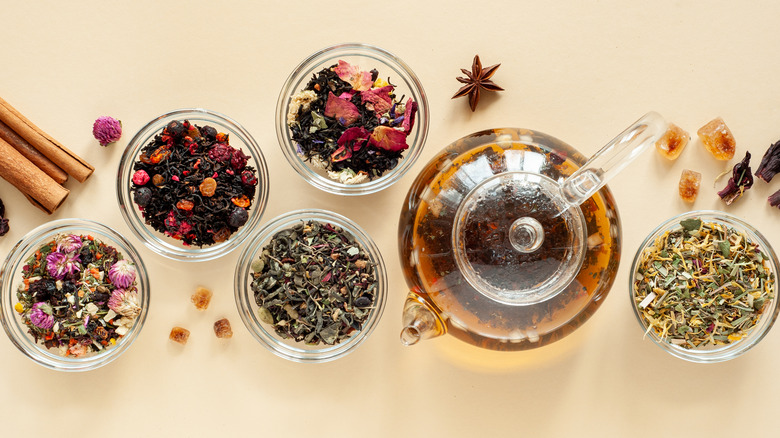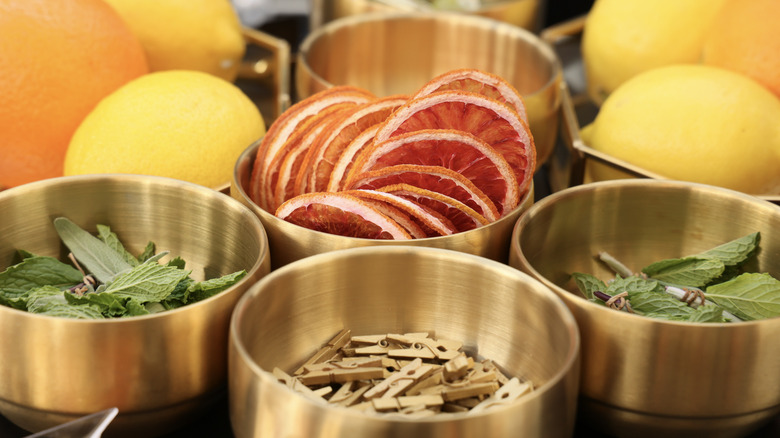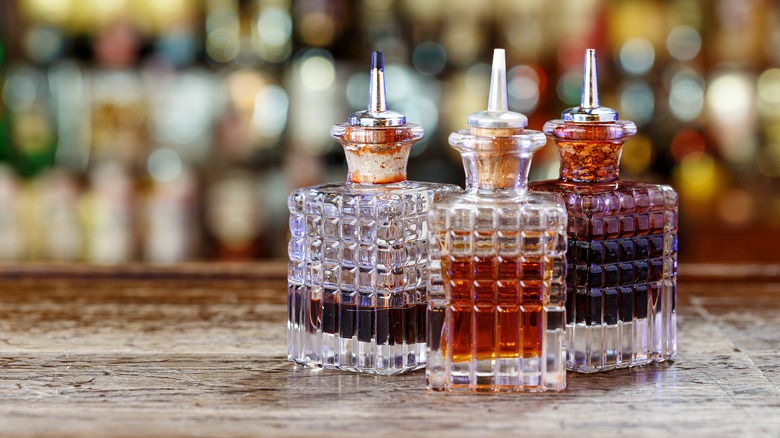12 Ingredients To Elevate Mocktails At Home
Every year, January comes around and — after a month of indulging in all of the drunken holiday festivities — you feel inspired to make real changes in your life. For many of us, that includes drinking less alcohol. However, the truth is, that's not the only time most of us have considered limiting our alcohol intake. In fact, one could bet that you've sworn off the stuff on multiple occasions, particularly in the mornings or even days spent hungover in bed. That is, until the next weekend comes around and, almost habitually, you're reaching for a drink someone poured for you without even asking. However intentional or unintentional the circumstances, there's no escaping the fact that alcoholic beverages are the norm.
That being said, it's no wonder that, as Dry January — the time of the year when it's the most acceptable to cut out alcohol — rolls into "wet February," some may find themselves drinking just as much alcohol as they did before, if not more. Turns out, a hard cut-off doesn't work in everyone's best interest. But, that's why you have mocktails. What's a mocktail? It's a mock cocktail — and the best ones taste, act, and feel just like a real drink would, without the alcohol. With one in hand, you'll avoid all of the awkward conversations about why you might not be drinking. Plus, you'll get the social comfort of simply holding something. They just need the right ingredients.
Probiotic beverages
When you're ordering mocktails out, you're usually limited to what they have on the menu — and, depending on where you go, those could be as artfully curated as the cocktails are or as plain and boring as a sparkling tea. The thing is, with the rise in craft cocktails, mocktails have to feel extravagant to come close. That's not easy to do if all you have to choose from is soda and juice. While that may be out of your control in most cases, it's not if you're making your own mocktail at home. In which case, those fermented, probiotic sodas and sparkling kombuchas you reserve for your self-deligated afternoon lunch break will come in handy.
Probiotic sodas are just like regular sodas — but better, and that's especially so in the case of your mocktails. Not only do they include all of those gut-friendly strains of pre and pro-biotics that everyone boasts about, but they also come in lots of tasty flavors. From tropical punch, the Olipop flavor Tasting Table ranked the best, to strawberry vanilla, and from lemon-lime to classic grape, there's a probiotic version of the soda in your go-to mixed drink order, guaranteed. Only, the reason why they're so beneficial in mocktails is because, just like alcoholic spirits, they're fermented and impart a flavor that's much more similar to the taste of alcohol. When used in place of soda or water, kombucha has the same effect. As does a spoonful of apple cider vinegar.
Adaptogenic drinks
Adaptogenic drinks are even less likely to appear on the non-alcoholic beverage list than probiotic soda is — but that won't be for long. As drinking alcohol becomes less and less trendy over time, more and more alternatives are appearing. In fact, if you walk into your local health-food store, Whole Foods Market, or even Target, you'll be able to find something colorful and canned, containing anything from ashwagandha to herbs and botanicals that are known to alter your mood. That's right, with one of these stocked inside of your fridge, you can make a mocktail that has all the same powers as you're usual pre-date drink, giving you all the confidence and contentment you thrive off of in social situations.
Some brands to look out for next time you're at the store include Kin Eurphorics and Ghia, but there are many, many others. Kin Euphorics, for example, offers cans of pre-made non-alcoholic beverages that are mixed with adaptogens, nootropics, and botanics like L-theanine — the amino acid found in matcha that eases anxiety — 5-HTP, gaba, reishi mushrooms, and L-Tryptophan. But, they also offer beverages that are made to be mixed, so you can make your own adaptogenic-infused mocktail inside your very own home. The same can be said for Ghia, which makes a non-alcoholic apéritif that includes a potent amount of natural herb extracts that are sure to bring out your best self.
CBD
CBD-infused cocktails have been having a bit of a moment, and it's only the beginning. You may have come across the minimally designed cans labeled "Recess" in the fridge at your favorite cafe or market and wondered what they might be. While they may not be labeled as alcohol alternatives, they are — especially if you're someone who enjoys a glass of wine or a nightcap to top off your day. That's because, if you're unfamiliar, CBD — an active chemical derived from hemp plants — is known to help with anxiety and insomnia. Despite many peoples' confusion, it does not actually contain any THC, and therefore it will not get you high or exhibit any signs of potential abuse or dependence. It's actually quite the opposite.
When mixed into your mocktails, CBD can provide you with a nice, relaxing feeling similar to drinking alcohol. The best part is, though, that some studies show that CBD can actually help minimize your cravings for alcohol. Legal in all 50 states, CBD is also readily obtainable, although, depending on where you live, the restrictions will vary. Quality is important, however, so look for organic CBD oils that have a COA label and start by dropping in 25 milligrams and go from there. It will have a slightly grassy flavor, so consider that when you're mixing it with your other mocktail ingredients — ginger or herbs like rosemary and thyme are recommended. But you can also make a syrup out of it that will mix better.
Kava
CBD and adaptogens have come to be relatively normalized. Kava, while comparatively less known, is no different. But, what is kava? Made from the ground roots of the kava plant and water, kava has been used as a ceremonial drink in the Pacific Islands for hundreds of years. In recent years establishments known as kava bars have been popping up across the U.S., serving the drinks as an alternative to traditional alcoholic beverages. People often describe feeling a sense of calm and relaxation after drinking it. The only thing is that kava has a murky, brown color and muddy texture. Unfortunately, it doesn't taste much better than it looks.
Earthy in taste and aroma, kava isn't everyone's cup of tea — but that isn't to say you can't make a mocktail out of it. You can purchase kava whole and make it the traditional way, or you can get it in a liquid or tincture form. These both should eliminate the issue of texture, however, they still may come with an earthy flavor. That's something you can work with, though. For instance, sweet, tropical, and citrus flavors can help balance the flavor. Margaritas are fair game, as well as mint mojitos, as they both deliver fresh, bright, and sweet flavors that can subdue the funky flavor of the kava. While used safely for hundreds of years, it may not be for everyone. If you have liver issues it is recommended that you speak with a doctor before drinking kava.
Textural ingredients
Texture is an important element in regular cocktails, and, to make a mocktail that stands up to the real deal, you have to incorporate at least one ingredient that plays into that. There are a handful of magic ingredients that will add familiar textures to your mocktails — most of which are used in alcoholic beverages too. For example, egg whites are used in both whiskey sours to pisco sours. Using a technique known as dry shaking, the whites of an egg are emulsified along with the other ingredients inside of your cocktail shaker. The resulting drink then comes out with a nice, frothy layer on top of it. You can use aquafaba in your cocktails and mocktails if you're allergic to or don't eat eggs, too. But there are many other ways to experiment with adding texture to your mocktails, too.
As is seen in fat-washing, the process of infusing cocktails with fat, integrating ingredients like butter or coconut oil into your cocktails provides it with a sweet or slightly salty thickness — and you could make it work in your mocktails, too. Although considering your drink won't include any alcohol, it may need to be adapted to account for the slightly higher melting point. There are easier options, though. Syrups often lend a nice texture to non-alcoholic drinks. Then, there are the more explorative options, such as steeping kombu for a more glutenous texture or making a whey cordial. It all depends on how experimental you're feeling.
Lemon extract
You may have heard of Arizona's Espiritu — the restaurant bar that will light any cocktail you want on fire. It's flashy for sure, and not always necessary, but there's something about lighting stuff on fire that makes people excited to drink. However, without the alcohol, fire is assumed to be one of the elements that you miss out on when drinking mocktails. But, as it turns out, all you need is a bit of lemon extract. Not to be confused with lemon juice, lemon extract is made from the flavorful oils that are extracted from the fruit by soaking the peels in alcohol. It's bold and pure, but not at all as sour as you might expect. So, keep that in mind if you're planning on using it to light up your mocktail.
Playing with fire isn't funny business, so, if you're going to be using lemon extract to light your mocktail on fire you should take precautions. The best and safest way to do it is to soak any garnishes you're using in the lemon extract itself. Simply fill a bowl with the lemon extract and drop in your citrus peel or sugar cubes so that they're completely doused in it. Then, garnish, light, and your mocktail will be a-flame. The bold, deep flavor the lemon extract lends will pair especially well with other sweet-bitter-citrus-forward drinks, such as non-alcoholic Aperol Spritz or other wine-based cocktails.
Something with some heat
A common culprit with mocktails is that they're too sweet, and much of that can be attributed to the ingredients used, but also because of the mere fact that they lack alcohol. You all know that face that people make when taking a shot of tequila, vodka, whiskey, or really any spirit — that almost sour look, where you purse your lips, hold your breath, and hope for the moment to pass. It's what makes many of us wonder why we drink in the first place. The word professionals use to describe that taste is piquancy. That sharp burn that is inherent to the taste of alcohol is something that's all too commonly forgotten when crafting mocktails. However, there are ways to recreate it without it.
White or black pepper, ginger syrup, and chili extract are other common ingredients used for this purpose. Not only will this make your mocktails more like the real thing, but it will also keep you or your guests from drinking too quickly — and it's not only reserved for your alcohol-free spicy margarita.
Fancy ice cubes
Going along with piquancy, another term that's used to describe the flavor of alcohol is length. Length refers to the amount of space alcohol takes up in a drink, and it correlates with the flavor intensity. Considering that mocktails don't contain any alcohol, you have to find ways to make up for it. Otherwise, when you shake it up and pour it over ice, and that ice melts, your drink is going to end up tasting more like water than anything. A nice, cold sparkling soda, kombucha, or non-alcoholic beer are all great options — or, you can hop onto the fancy ice cube trend.
You've seen them — the videos of freezers full of extravagant ice cubes. Some are made with fruit, coffee, herbs, veggies, and even flowers, and others are made in different shapes and sizes. When making ice for your mocktail, the easiest way to maintain the balance and length in your recipe is to simply take the juice used in it and make ice out of it. You don't have to get too crazy, but, for example, if you were making non-alcoholic mimosas, you could make ice cubes out of orange juice. Sticking with the brunch drinks, you could also use tomato juice to make ice cubes for your bloody maries. That way, when they melt, they won't dilute your already watery mocktail.
Oleo-saccharum
Whether it's cocktail hour or mocktail hour, you can make it more sustainable — and elevated. Oleo-saccharum is an oil syrup that has been a key bar-tending ingredient since 1982, and it's made from old fruit scraps and peels. Whether it's a banana, lemon, grapefruit, lime, or orange, if you save your fruit peels and scraps, you can use them to make oleo-saccharum. All you have to do is toss them into a bowl with some sugar and let them sit for 24 hours. After that, you should be able to press the fruit scraps and extract their oils to get a homemade sweet fruit syrup that you can use in any mocktail you can imagine.
Good in your refrigerator for about a week, you can take last week's fruit scraps and use them to elevate this week's cocktail hour, all week long. In combination with shopping locally, and opting for organic fruit whenever possible, oleo-saccharum is just one way to reduce your produce while elevating your mocktails.
Tea
Along with fermented beverages, tea is a common ingredient that is utilized in mocktails to recreate the flavors of certain spirits. Herbal teas tend to mimic the many botanicals that are present in gin, and chamomile tea is one ingredient you can use to mimic vodka. Chamomile also happens to be the tea of choice when mocktails of drinks that would otherwise use tequila — and you can even reach for lapsang souchong tea leaves if you want to give your mocktail a mezcal or scotch-like smoke.
When recreating drinks that would typically use a dark spirit such as whisky, heavier, darker teas like traditional black teas, and oolongs work best. But, how exactly do you mix them into your mocktail? You have two options — you can use your chosen tea to make an iced tea and simply pour and shake it like any other cocktail ingredient, or, you can crush the leaves up with any fruit or herbs you're using in your mocktail to release their aromas, then shake and strain. Either way, you'll get the flavor you're looking for while simultaneously reducing the amount of water in your mocktail which will, therefore, further create a flavor more comparable to alcoholic cocktails.
Garnishes
Garnishes are the last touch that brings a cocktail together. Whether it's an edible flower, fresh herbs, or dried fruit, a garnish is just one way to set your mocktail apart from other non-alcoholic drinks. Like the dried orange that's placed on top of your Old Fashioned, or the fresh mint stemming from your refreshing mojito, garnishes aren't dependent on the use of alcohol, and in all cases, you can stick to whatever the regular recipe would call for. However, if you're hoping to elevate your mocktail experience, there's no reason why you can't get creative with them.
For instance, if you're making a lemon drop or a lemon martini, the obvious garnish would be a lemon peel. However, to take it to the next level, you can twist the peel so that it wraps along the sides of the inside of your glass. You can do the same thing with cucumbers and other citrus fruits, too. An edible flower is also never a bad idea, no matter what the drink is. When adding herbs, whether that be a blackberry or rosemary sprig, cilantro, mint, or basil, you can intensify their aroma and flavor by lightly pressing them between your hands to release their oils.
It doesn't stop there. Mocktails can also benefit from a salted rim. The obvious accompaniment in this scenario is with a margarita, however, with the addition of a red chili pepper, it can give any of your mocktails that necessary heat while balancing sweetness.
Bitters
Bitters are commonly used in cocktails because the concentrated flavors add complexity to drinks. Sold in small bottles, and in flavors that range from chocolate to orange, you really only need a few drops of them to achieve the desired effect. That's why, despite containing ABV levels between 35% to 45%, you don't need to be of legal drinking age to purchase them, because bitters don't make any noticeable contribution to the alcohol percentage of your drink. So, technically, you're free to use them in your mocktails, too. With just a drop or two, it will give your non-alcoholic drinks a noticeably deeper and more complex flavor. However, if you're a stickler about cutting out all of the alcohol from your drinks, you can buy or make your own non-alcoholic bitters at home.
Two of the advantages of making bitters at home is that you can customize the flavors, and make them non-alcoholic. All you need is your choice of aromatic herbs, spices, fruits, and botanicals, and some apple cider vinegar. Simmered and infused in the apple cider vinegar, all that's left to do is wait. After about two weeks in the fridge, your bitters will be ready to be strained, bottled, and dripped into all of your mocktail recipes. From lavender and lemon to chocolate and orange, and from cinnamon and clove to coffee and pecan, the flavors only develop more over time, and your mocktails will benefit — whether they're made at home or bought at the store.
